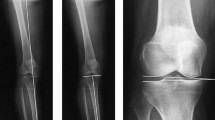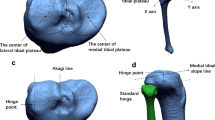Abstract
Purpose
This study aimed to evaluate and compare unilateral and bilateral open-wedge high tibial osteotomy (OWHTO) using mid-term serial assessment of clinical and radiological outcomes, especially focussing on coronal lower extremity alignment.
Methods
Serial radiological assessments were performed in 40 patients (80 knees) with bilateral OWHTO and 49 patients (49 knees) with unilateral OWHTO. Both groups were further divided into four subgroups to compare each limb (unilateral involved and non-involved limbs and bilateral primarily and secondarily treated limbs). Radiological and clinical outcomes were evaluated and compared among the four groups. For the alignment change assessment, the pelvic tilt angle (PTA), weight-bearing line ratio (WBLR), joint line orientation angle (JLOA), medial proximal tibia angle (MPTA), joint line convergence angle (JLCA), distal tibia articular angle (DTAA), and talar inclination (TI) were measured pre- and postoperatively at 3, 6, and 12 months and annually thereafter. Student’s t-test, one-way repeated-measures analysis of variance, and correlation analysis were used to compare the groups.
Results
Patients in the unilateral and bilateral OWHTO groups had similar postoperative radiological and clinical outcomes. Each unilaterally involved limb and primarily treated bilaterally involved limb were negatively affected by the contralateral limb with respect to increased JLOA during the postoperative period (unilateral OWHTO group: r = −0.350, p = 0.023; bilateral OWHTO group: r = −0.520, p = 0.005). The correction change of the ankle parameters in the secondarily treated limb showed greater varus alignment than the primarily treated limb after bilateral OWHTO (DTAA (0.1 ± 3.0 vs. –0.5 ± 3.8°, p = 0.014) and TI (0.9 ± 3.2° vs. –0.3 ± 2.9, p = 0.001)).
Conclusion
Unilateral and bilateral OWHTOs shared similar postoperative radiological and clinical outcomes. Alignment changes of the unilateral OWHTO and the primarily treated limb of the bilateral OWHTO were associated with the JLOA of the contralateral limb.
Level of evidence
Cohort study; Level III.





Similar content being viewed by others
References
Bohm ER, Molodianovitsh K, Dragan A, Zhu N, Webster G, Masri B et al (2016) Outcomes of unilateral and bilateral total knee arthroplasty in 238,373 patients. Acta Orthop 87(Suppl 1):24–30
Choi GW, Yang JH, Park JH, Yun HH, Lee YI, Chae JE et al (2017) Changes in coronal alignment of the ankle joint after high tibial osteotomy. Knee Surg Sports Traumatol Arthrosc 25:838–845
Kang BY, Lee DK, Kim HS, Wang JH (2022) How to achieve an optimal alignment in medial opening wedge high tibial osteotomy? Knee Surg Relat Res 34:3
Kaufman KR, Miller LS, Sutherland DH (1996) Gait asymmetry in patients with limb-length inequality. J Pediatr Orthop 16:144–150
Kim YH, Dorj A, Han A, Kim K, Nha KW (2016) Improvements in spinal alignment after high tibial osteotomy in patients with medial compartment knee osteoarthritis. Gait Posture 48:131–136
Kim JH, Kim HJ, Lee DH (2017) Leg length change after opening wedge and closing wedge high tibial osteotomy: a meta-analysis. PLoS ONE 12:e0181328
Kim JE, Kim DH, Lee JI, Choi HG, Jung YS, Lee SH et al (2021) Difference of preoperative varus-valgus stress radiograph is effective for the correction accuracy in the preoperative planning during open-wedge high tibial osteotomy. Knee Surg Sports Traumatol Arthrosc 29:1035–1044
Lee WC, Moon JS, Lee HS, Lee K (2011) Alignment of ankle and hindfoot in early stage ankle osteoarthritis. Foot Ankle Int 32:693–699
Lee WC, Moon JS, Lee K, Byun WJ, Lee SH (2011) Indications for supramalleolar osteotomy in patients with ankle osteoarthritis and varus deformity. J Bone Joint Surg Am 93:1243–1248
Lee YS, Kim MK, Byun HW, Kim SB, Kim JG (2015) Reliability of the imaging software in the preoperative planning of the open-wedge high tibial osteotomy. Knee Surg Sports Traumatol Arthrosc 23:846–851
Lee YS, Lee MC, Kang SG, Elazab A, Oh WS (2016) Open-wedge high tibial osteotomy using a protective cutting system: technical advancement for the accuracy of the osteotomy and avoiding intraoperative complications. Arthrosc Tech 5:e7–e10
Lee OS, Ahn S, Lee YS (2017) Effect and safety of early weight-bearing on the outcome after open-wedge high tibial osteotomy: a systematic review and meta-analysis. Arch Orthop Trauma Surg 137:903–911
Lee OS, Lee SH, Lee YS (2018) Does coronal knee and ankle alignment affect recurrence of the varus deformity after high tibial osteotomy? Knee Surg Relat Res 30:311–318
Lee OS, Kwon O, Lee YS (2018) Comparison of the outcome between unilateral and bilateral open wedge high tibial osteotomy in the bilateral varus knees. Arch Orthop Trauma Surg 138:307–316
Lee ES, Kim TW, Jo IH, Lee YS (2020) Comparative analysis of fixation configurations and their effect on outcome after medial open-wedge high tibial osteotomy. J Orthop Sci 25:627–634
Martimbianco AL, Calabrese FR, Iha LA, Petrilli M, Lira Neto O, Carneiro Filho M (2012) Reliability of the “American Knee Society Score” (AKSS). Acta Ortop Bras 20:34–38
Mazzuca SA, Brandt KD, Lane KA, Chakr R (2011) Malalignment and subchondral bone turnover in contralateral knees of overweight/obese women with unilateral osteoarthritis: implications for bilateral disease. Arthritis Care Res (Hoboken) 63:1528–1534
Nerhus TK, Ekeland A, Solberg G, Sivertsen EA, Madsen JE, Heir S (2017) Radiological outcomes in a randomized trial comparing opening wedge and closing wedge techniques of high tibial osteotomy. Knee Surg Sports Traumatol Arthrosc 25:910–917
Norton AA, Callaghan JJ, Amendola A, Phisitkul P, Wongsak S, Liu SS et al (2015) Correlation of knee and hindfoot deformities in advanced knee OA: compensatory hindfoot alignment and where it occurs. Clin Orthop Relat Res 473:166–174
Reising K, Strohm PC, Hauschild O, Schmal H, Khattab M, Südkamp NP et al (2013) Computer-assisted navigation for the intraoperative assessment of lower limb alignment in high tibial osteotomy can avoid outliers compared with the conventional technique. Knee Surg Sports Traumatol Arthrosc 21:181–188
Schwab F, Patel A, Ungar B, Farcy JP, Lafage V (2010) Adult spinal deformity-postoperative standing imbalance: how much can you tolerate? An overview of key parameters in assessing alignment and planning corrective surgery. Spine (Phila Pa 1976) 35:2224–2231
Seo H, Lim D, Jang YW, Kang KS, Lee MC, Lee OS et al (2020) Distribution of the force in the knee joint during daily activities after open wedge high tibial osteotomy: a rationale for the proper postoperative management. J Knee Surg 33:158–166
Sesen H, Demirkale I, Karaduman M, Vural CA, Okkaoglu MC, Altay M (2015) Why two-thirds of patients accepted the second session in staged bilateral total knee arthroplasty: a prospective analysis of 111 patients. Knee Surg Sports Traumatol Arthrosc 23:3585–3590
Shaw JA, Dungy DS, Arsht SS (2004) Recurrent varus angulation after high tibial osteotomy: an anatomic analysis. Clin Orthop Relat Res 420:205–212
Shrader MW, Andrisevic EM, Belthur MV, White GR, Boan C, Wood W (2018) Inter- and intraobserver reliability of pelvic obliquity measurement methods in patients with cerebral palsy. Spine Deform 6:257–262
Sim JA, Kwak JH, Yang SH, Choi ES, Lee BK (2010) Effect of weight-bearing on the alignment after open wedge high tibial osteotomy. Knee Surg Sports Traumatol Arthrosc 18:874–878
Sischek EL, Birmingham TB, Leitch KM, Martin R, Willits K, Giffin JR (2014) Staged medial opening wedge high tibial osteotomy for bilateral varus gonarthrosis: biomechanical and clinical outcomes. Knee Surg Sports Traumatol Arthrosc 22:2672–2681
Takeuchi R, Saito T, Koshino T (2008) Clinical results of a valgus high tibial osteotomy for the treatment of osteoarthritis of the knee and the ipsilateral ankle. Knee 15:196–200
Wang D, Willinger L, Athwal KK, Williams A, Amis AA (2021) Knee joint line obliquity causes tibiofemoral subluxation that alters contact areas and meniscal loading. Am J Sports Med 49:2351–2360
Funding
This work was supported by the National Research Foundation of Korea(NRF) grant funded by the Korea government(MSIT) No.2021R1A2C1092657.
Author information
Authors and Affiliations
Corresponding author
Ethics declarations
Conflict of interest
The authors declare that they have no conflicts of interest.
Ethical approval
This article does not contain any studies with human participants or animals performed by any of the authors.
Additional information
Publisher's Note
Springer Nature remains neutral with regard to jurisdictional claims in published maps and institutional affiliations.
Supplementary Information
Below is the link to the electronic supplementary material.
Rights and permissions
Springer Nature or its licensor holds exclusive rights to this article under a publishing agreement with the author(s) or other rightsholder(s); author self-archiving of the accepted manuscript version of this article is solely governed by the terms of such publishing agreement and applicable law.
About this article
Cite this article
Park, S.B., Lee, Y.S. Association of the joint line orientation angle of the contralateral limb with the alignment change of the unilateral and bilateral opening-wedge high tibial osteotomy. Knee Surg Sports Traumatol Arthrosc 31, 1593–1602 (2023). https://doi.org/10.1007/s00167-022-07123-y
Received:
Accepted:
Published:
Issue Date:
DOI: https://doi.org/10.1007/s00167-022-07123-y




